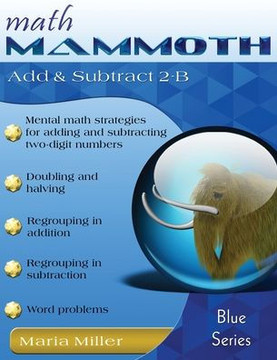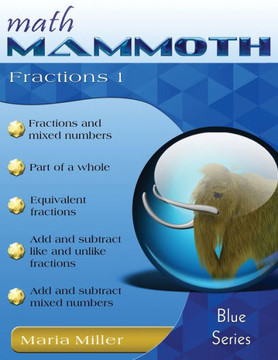
Math Mammoth
Math Mammoth Subtraction 1
Product Code:
9781954358621
ISBN13:
9781954358621
Condition:
New
$17.50
$16.47
Sale 6%
Math Mammoth Subtraction 1 is a worktext that covers the concept of subtraction, the relationship between addition and subtraction, and the various meanings of subtraction. In the first lesson, Subtraction Is Taking Away, the child learns the basic meaning of subtraction as taking away objects, and learns to write subtractions from an illustration where some objects are crossed out. In the next lesson, the child counts down to subtract, which ties in subtraction with the number line. This is a transitional strategy to solve subtraction problems, because later students will learn more efficient ways to subtract, but it is important conceptually. The following lesson, Subtraction and Addition in the Same Picture, begins the study of the relationship between addition and subtraction. This concept will span several lessons. This first lesson presents two sets of objects, such as blue and white balls, and the student writes both an addition sentence and a subtraction sentence from this illustration. The lesson When Can You Subtract? concentrates on the idea that some subtractions, such as 4 - 5, are meaningless when you think of taking away. The child also makes subtraction patterns in this lesson. Then we continue studying the connection between addition and subtraction in the lesson Two Subtractions from One Addition. As an example, the child writes both 8 - 3 = 5 and 8 - 5 = 3 from the addition 3 5 = 8. This idea ties in with fact families, a concept that is coming up soon. In the lesson Two Parts - One Total, we study word problems that do not involve the idea of taking away but have two parts making up a total. For example, if there are 10 flowers of which some are white and some are red, and seven of them are white, how many are red? Then we study fact families, which means writing two additions and two subtractions using the same three numbers. In the lesson How Many More? students find how many more or how many fewer objects one person has than the other by drawing the objects. This lesson can easily be done with manipulatives if desired. In the very next lesson, "How Many More" Problems and Differences, we continue the theme, this time writing a missing addend addition for problems that ask "how many more." For example, Veronica has 4 marbles and Ann has 6. We write the missing addend sentence 4 ___ = 6 to find how many more Ann has. In the next lesson the child then learns to write subtraction sentences for such problems.
| Author: Maria Miller |
| Publisher: Math Mammoth |
| Publication Date: Apr 06, 2024 |
| Number of Pages: NA pages |
| Language: English |
| Binding: Paperback |
| ISBN-10: 1954358628 |
| ISBN-13: 9781954358621 |

Math Mammoth Subtraction 1
$17.50
$16.47
Sale 6%
Math Mammoth Subtraction 1 is a worktext that covers the concept of subtraction, the relationship between addition and subtraction, and the various meanings of subtraction. In the first lesson, Subtraction Is Taking Away, the child learns the basic meaning of subtraction as taking away objects, and learns to write subtractions from an illustration where some objects are crossed out. In the next lesson, the child counts down to subtract, which ties in subtraction with the number line. This is a transitional strategy to solve subtraction problems, because later students will learn more efficient ways to subtract, but it is important conceptually. The following lesson, Subtraction and Addition in the Same Picture, begins the study of the relationship between addition and subtraction. This concept will span several lessons. This first lesson presents two sets of objects, such as blue and white balls, and the student writes both an addition sentence and a subtraction sentence from this illustration. The lesson When Can You Subtract? concentrates on the idea that some subtractions, such as 4 - 5, are meaningless when you think of taking away. The child also makes subtraction patterns in this lesson. Then we continue studying the connection between addition and subtraction in the lesson Two Subtractions from One Addition. As an example, the child writes both 8 - 3 = 5 and 8 - 5 = 3 from the addition 3 5 = 8. This idea ties in with fact families, a concept that is coming up soon. In the lesson Two Parts - One Total, we study word problems that do not involve the idea of taking away but have two parts making up a total. For example, if there are 10 flowers of which some are white and some are red, and seven of them are white, how many are red? Then we study fact families, which means writing two additions and two subtractions using the same three numbers. In the lesson How Many More? students find how many more or how many fewer objects one person has than the other by drawing the objects. This lesson can easily be done with manipulatives if desired. In the very next lesson, "How Many More" Problems and Differences, we continue the theme, this time writing a missing addend addition for problems that ask "how many more." For example, Veronica has 4 marbles and Ann has 6. We write the missing addend sentence 4 ___ = 6 to find how many more Ann has. In the next lesson the child then learns to write subtraction sentences for such problems.
| Author: Maria Miller |
| Publisher: Math Mammoth |
| Publication Date: Apr 06, 2024 |
| Number of Pages: NA pages |
| Language: English |
| Binding: Paperback |
| ISBN-10: 1954358628 |
| ISBN-13: 9781954358621 |





